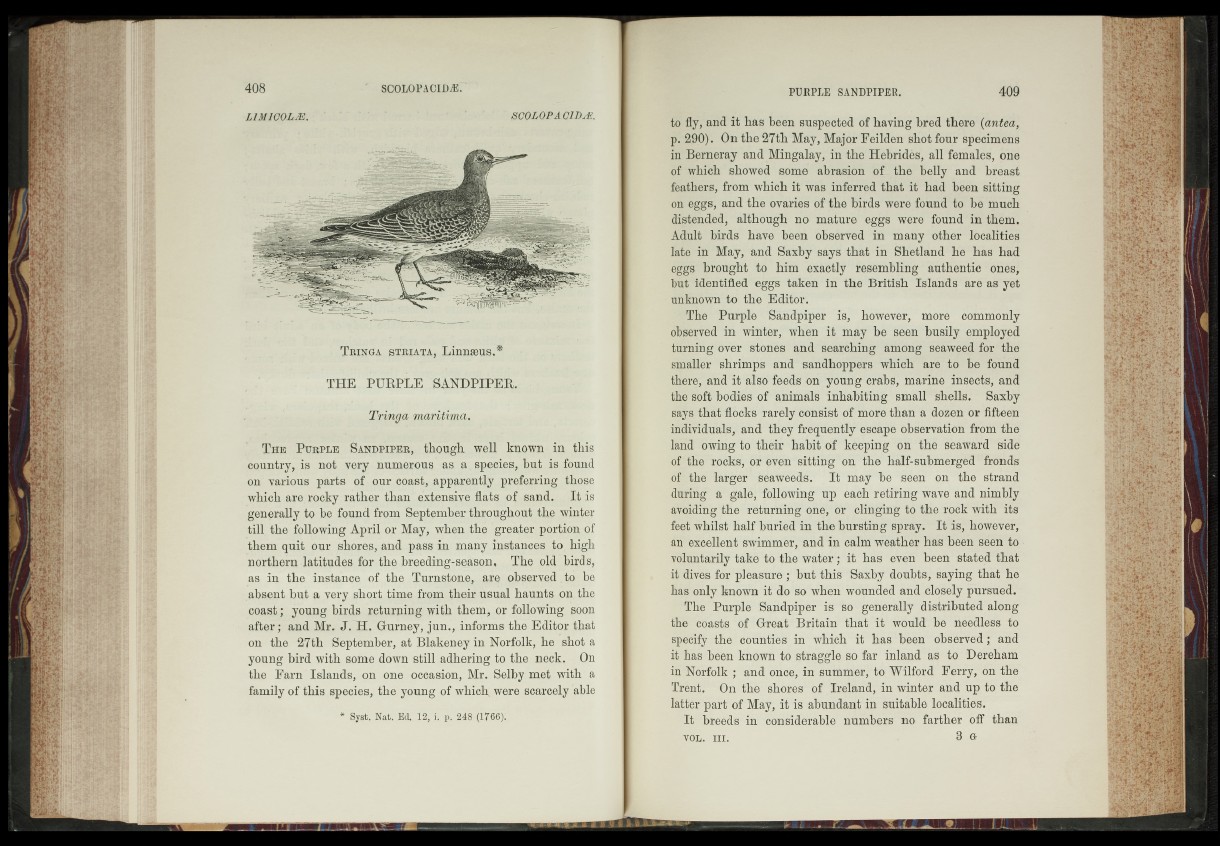
L1M1COLÆ. ; * '** ' J ’ 7- ‘ * ' t gCQMP-àGLDÆ,
Tringa striata, Linnæus,*
THE PURPLE SANDPIPER.
Trim a myzijiffljii.
The Purple Sandpiper, though, well known in |h.is
country, is not very numerous as, a speeiep^hiit.js found
on various parts of our coast, apparently _preferring tlp^se
which are, rocky rather than extensive flats of sand.|i|Dfciis
generally to he found from September throughout the winter
till the following April or May, when the greater portion of
them quit our shores, and pass in many instances t*of high-
northern latitudes for -the breeding-season * .,T,b§,old Linds,
as in the' instance of the Turnstone, are observed .to be
absent but a very short time from their usual haunts on, the
coast. 1 young birds returning with them, or following soon
after; and Mr- J. H. Gurney, jun., informs the Editor that
on the 27th September, at Blakeney in Norfolk, he shot a
young bird with some down still adhering to,the neck. On
the Earn Islands, on one occasion, Mr.> Selby met with a
family of this species, the young of which, were scarcely able
* Syst. Nat. Ed, Xr2,"®i.' p. 248 (1766),%
to fly, and it has been suspected of having bred there (anted,
p. 290). On the 27th May, Major Feilden shot four specimens
in Berneray and Mingalay, in the Hebridès, all females, one
of which showed some abrasion oL the belly and breast
feathers, from which it was inferred that it had been sitting
on eggs, and the ovaries óf the birds were found to be much
distended, although no mature eggs were found in them.
Adult birds have been observed in many other localities
late in May, and Saxby says that in Shetland he has had
eggs brought to him exactly resembling authentic onesf
but identified eggs taken in the British Islands arë as yet
unknown to the Editor.
The Purple Sandpiper is, however, moré commonly
observed in winter, when it may be seen busily employed
turning over stones and searching among seaweed for the
smaller shrimps and sandhoppers whièhare tor be found
there, and it cjStÏ8& feeds on young crabs, marine insects,1 and
the "Soft bodies’of animals inhabiting small" ^shells. Saxt||
says that flocks rarely consist of more than a dozen or fifteen
individuals, and they frequently escapé observation from the
land owing to their habit1 of1'kêéping'^on the seaward side
of thé rocks, ór èven^sitting^on the half-submergé?!' fronds
of the larger seaweeds. It may be "seen bn the strand
during â' galë, following up each'retiring wave and nimbly
avoiding*the returning" one,.' or clinging to the rock with its
fëèt whilst half burièd'in the bursting spray. I t is) however,
anlnSellent swimméîf and in calm weather has been seen to)
voluntarily takeho Jthe water ; it has even been stated that
firfiives for pleasure ; but this Saxby doubts, saying thàt he
has only known it do so when wounded and'closely pursued.“
;®The Purple Sandpiper is 'ko generally distributed along
the^chasts ' 6f Great Britain thaf^it would-be heedless ~fco
specify the counties in which it has been observed ; and
it has been known to straggly so far inland *as to ' Dereham'
in l^orfdlk ; and once, in summer, to Wilford Ferry^bn the
Trent. On. thê:/lhörës bf Ireland, in winter and uptb the
latter partof May; fins abundant in suitable'localitiesi
It breeds Un considerable numbers rib farther off than
VOL. III. 3 G